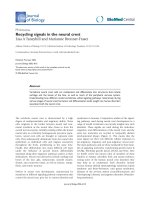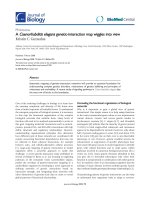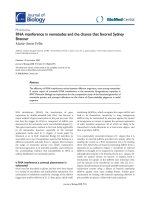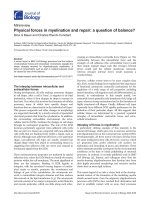Báo cáo sinh học: " Making progress in genetic kin recognition among vertebrates" docx
Bạn đang xem bản rút gọn của tài liệu. Xem và tải ngay bản đầy đủ của tài liệu tại đây (1.26 MB, 4 trang )
Across a very broad taxonomic range animals frequently
respond differentially to close kin, even if those kin were
previously unfamiliar. Logically, this differentiation
between individuals according to kinship requires well-
defined mechanisms to allow recognition. And whereas
animals may learn the cues of familiar individual kin
during rearing, recognition of unfamiliar kin must really
be recognition of genetic similarity – either to self or to
other known kin. A challenge in this area lies in
discovering the cues that animals use for genetic
recognition of kin, and the genetic encoding of such cues.
In many vertebrates, odors are key to the recognition
process, and have been widely implicated as cues that
allow genetic kin recognition in many species of fish,
reptiles and mammals (Figure 1). However, vertebrate
scents are generally complex, and there have been few
attempts to identify the specific scent components used
in kin recognition or their genetic basis.
Gene-odor covariance
In work published recently in BMC Evolutionary Biology,
Boulet and colleagues [1] have advanced this field by
demonstrating a significant correlation between genetic
similarity (estimated from 11-14 microsatellite loci) in a
captive population of ring-tailed lemurs (Lemur catta)
and similarity of volatile chemicals in their genital gland
secretions, as assessed by gas-chromatography mass-
spectrometry. e genetic similarity of two individuals is
thus manifest in the odor profile (sometimes referred to
as an ‘odortype’). Even more intriguing, although the
genital glands of the two sexes are anatomically distinct
(scrotal glands in the male, labial glands in the female),
this covariance between genetic and chemical similarity
is evident even between individuals of the opposite sex.
While some components are expressed only by animals
of one sex, more than half (about 170) were expressed by
individuals of both sexes. To provide a simple estimate of
chemical distance between a pair of individuals, Boulet et
Abstract
A recent study in BMC Evolutionary Biology has shown
that genetically similar individual ring-tailed lemurs
are also more similar in their scent composition,
suggesting a possible mechanism of kin recognition.
Theoretical and experimental studies reveal challenges
ahead in achieving a true systems-level understanding
of this process and its outcomes.
© 2010 BioMed Central Ltd
Making progress in genetic kin recognition among
vertebrates
Jane L Hurst*
1
and Robert J Beynon
2
See research article />M IN I R E VI E W
*Correspondence:
1
Mammalian Behaviour and Evolution Group, School of Veterinary Science,
University of Liverpool, Leahurst Campus, Neston CH64 7TE, UK
2
Proteomics and Functional Genomics Group, School of Veterinary Science,
University of Liverpool, Crown Street, Liverpool L69 7ZJ, UK.
Figure 1. Ring-tailed Lemur (Lemur catta) using perianal glands
for scent marking. (Photograph by Alex Dunkel/Visionholder).
Hurst and Beynon Journal of Biology 2010, 9:13
/>© 2010 BioMed Central Ltd
al. used the relative abundance of each of these shared
compounds to calculate the Euclidean distance between
the pair (derived from the Pythagorean theorem, this
sums the pairwise difference, ∆, in abundance of all 170
compounds, such that chemical distance = SQRT(∆
1
2
+
∆
2
2
+∆
3
2
+….∆
170
2
). While there was a broad spread of
chemical distances between male-female dyads that had
intermediate genetic distance, dyads with low genetic
similarity had low chemical similarity whereas those with
a high genetic similarity had a higher chemical similarity.
is relationship is consistent with the hypothesis that
odors from genital secretions can be used to assess
genetic relatedness, and maybe close kinship. Of
particular interest, these relationships were significant
both within and between the sexes during the breeding
season, but were much weaker or nonsignificant during
the non-breeding season [1,2]. Odortype may be
particularly important during the competitive breeding
season to prevent inbreeding and/or to direct nepotistic
behavior towards more closely related individuals.
However, this study is still only a first step in
establishing whether such odor signals could offer a
reliable means of recognizing kinship among ring-tailed
lemurs and the genetic basis of the cues used. If lemurs
used a measure of chemical distance based on all volatile
compounds that are shared within or between the sexes,
it would only be of very limited value in assessing kinship
because of the considerable range in that measure
between individuals of intermediate genetic relatedness.
Although very closely related animals have similar
odortypes, so do many individuals that are much less
closely related. If odortype were used to avoid inbreeding,
for example, the consequence would be exclusion as
mates of many individuals that are not closely related,
reducing choice without gaining any genetic benefit. It is
likely, therefore, that animals use more specific markers
within the odortype to distinguish close relatives reliably
(Figure 2).
Genetic and molecular mechanisms used to assess
kinship
ere has been surprisingly little progress in
establishing the genetic and molecular markers used to
recognize kin through scents in vertebrates. In part,
this may be due to the molecular complexity of
vertebrate scents, which are the product not only of an
individual’s genes but also of hormonal and metabolic
status, diet and microflora. For the past 30 years, the
focus on genetic mechanisms underlying vertebrate kin
recognition through odors has been on the major
histocompatibility complex (MHC), which is often held
to be the major genetic component apparently
determining an individual’s scent. Inbred laboratory
mice have been a key model organism for manipulating
MHC genes on a constant genetic background as proof
that animals can detect MHC type through scent. As
MHC is so highly polymorphic in natural populations,
those that share the same MHC type (and MHC-based
scent) are very likely to be closely related – MHC odors
could be used as a marker of genetic relatedness. Yet,
despite the precise genetic control offered by
laboratory rodent strains, chemical analyses of volatile
profiles have found correlations of some volatile
components with MHC type but have not yet
discovered consistent differences in compounds that
are regulated by MHC type [3-6]. In reality, complex
interactions are found with genetic background,
Figure 2. Model of gene-odor covariance for the reliable
assessment of kinship. Chemical distance between pairs of
animals based on all volatile compounds in a scent correlates with
genetic distance (a), but variance will be high for any particular
genetic distance because some compounds are likely to be strongly
inuenced by non-genetic factors such as current hormone
levels and bacterial ora. Instead, selective assessment of specic
semiochemicals within the scent that correlate strongly with
genotype (b) will provide a much more reliable assessment of kinship.
(a)
(b)
Genetic distance
Genetic distance
Chemical distanceSemiochemical distance
Hurst and Beynon Journal of Biology 2010, 9:13
/>Page 2 of 4
microflora and diet, all of which alter the odor profile
[3,5-7].
is plasticity of MHC-derived odortype creates a
conundrum. To be useful in natural populations, kin
markers must be stable and readily recognized against
the variable genetic and environmental background of
normal outbred animals. Our own studies of wild-
derived mice with normal genetic variation in semi-
natural populations provided clear evidence that wild
mice do not use MHC to avoid inbreeding [8]. In fact,
mice showed a very strong avoidance of inbreeding with
those sharing another very highly polymorphic marker
in mouse scent, the major urinary proteins (MUPs),
which have a strong influence on an individual’s scent
profile regardless of other genetic and non-genetic
variation [9].
Sharing of a single highly polymorphic marker, like
MUP or MHC type, can provide a reliable indicator of
relatedness because only close relatives are likely to
inherit both of the same alleles at a particular locus (or
both of the same haplotypes in the case of clusters of
closely linked genes like MUP or MHC). However, this
type of mechanism can only be partially effective for kin
recognition. For any single locus, the number of alleles
shared between two relatives is a matter of chance; even
very close relatives such as full siblings are as likely to
share no alleles as they are to share both alleles at a
particular locus. Modeling alternative genetic
mechanisms that could be used to discriminate full sibs
from unrelated animals [10] reveals that reliance on a
single genetic locus will either fail to identify many
relatives (if the requirement is that both alleles are
shared) or will mistake many unrelated animals as sibs
(if sharing of any allele is used). Notwithstanding the
theory, house mice do use sharing of MUP type, encoded
by a single tightly linked cluster of genes, to avoid
inbreeding [8]. is may be specific to house mice –
there are insufficient data to assess whether such simple
recognition systems are widespread.
An alternative model is that instead of directly
comparing the similarity of scents to self, imprinting on
maternal scent encoded by several independent loci is
employed to provide reliable recognition of all siblings
and maternal half-sibs, because all offspring share with
their mother one allele at every locus [10]. Laboratory
cross-fostering studies in which newborn mouse pups
were fostered onto a mother of different MHC type to
their own have suggested that animals might imprint on
the genotype of their mother and subsequently avoid
‘inbreeding’ with those sharing the foster mother’s
genotype rather than avoiding mates that match their
own MHC type [11,12]. However, maternal imprinting
does not require recognition of the mother’s genotype
for kin recognition; instead animals must be able to
recognize the separate haplotypes carried by the mother
when these are combined with other unknown
haplotypes. is recognition task is likely to be
considerably more difficult given the complex effects
that MHC type has on odors, particularly as the odors of
MHC heterozygotes are not an additive combination of
the two homozygous profiles [3]. A key test would be
whether mice (or other animals) can recognize the
separate MHC haplotypes carried by a heterozygous
animal when combined with other MHC haplotypes (for
example, animals imprinted on the MHC
bd
haplotype
must be able to recognize MHC
bk
or MHC
dq
); they also
need to be able to do this on the randomly assorting
genetic background of outbred animals. Non-genetic
maternal effects could also contribute to maternal
imprinting for kin recognition. A recent study using
inbred laboratory mice found that animals recognized
non-genetic similarities in offspring from the same
mother compared to those from another genetically
identical female due to their shared maternal (in utero
and postnatal) environment [13].
The way forward
e approach of relating genetic similarity to the global
volatile profile of scent glands [1,2] is a step towards the
systems biology of complex behaviors. Indeed, the
application of global profiling methodologies to scents
could be said to introduce the concept (but preferably
not the term!) of ‘semiomics’. As with many studies of
this nature, the analyte mixtures are complex, and a
major challenge is in unbundling the important
semiochemicals from the entire volatile profile –
although Boulet and colleagues [1] refer to a
‘semiochemical profile’, it is likely that many of the
constituent compounds will be ‘silent’ in kin recognition.
An attractive way forward is to use the combined
datasets to identify those chemicals that show the
greatest correlation with relatedness, focusing on
differences in relatedness that can be discriminated
behaviorally. ese chemicals then become the first
candidates for testing with simple behavioral analyses.
e candidates can be examined in ‘kin-shifting’
experiments such that when they are spiked into a
distant sample, they elicit a response more ‘akin’ to a
close relative. Indeed, similar experiments could be
conducted using humans to establish the extent to which
we too can discriminate our own kin based on
genetically determined scents.
Acknowledgements
The development of these ideas was supported by research grants from
BBSRC (S19816, BBC603897) and NERC (NEG018650).
Published: 17 February 2010
Hurst and Beynon Journal of Biology 2010, 9:13
/>Page 3 of 4
References
1. Boulet M, Charpentier MJ, Drea CM: Decoding an olfactory mechanism of
kin recognition and inbreeding avoidance in a primate. BMC Evol Biol 2009,
9:281.
2. Charpentier MJ, Boulet M, Drea CM: Smelling right: the scent of male lemurs
advertises genetic quality and relatedness. Mol Ecol 2008, 17:3225-3233.
3. Willse A, Kwak J, Yamazaki K, Preti G, Wahl JH, Beauchamp GK: Individual
odortypes: interaction of MHC and background genes. Immunogenetics
2006, 58:967-982.
4. Novotny MV, Soini HA, Koyama S, Wiesler D, Bruce KE, Penn DJ: Chemical
identification of MHC-influenced volatile compounds in mouse urine.
I: Quantitative proportions of major chemosignals. J Chem Ecol 2007,
33:417-434.
5. Kwak J, Willse A, Matsumura K, Curran Opiekun M, Yi W, Preti G, Yamazaki K,
Beauchamp GK: Genetically-based olfactory signatures persist despite
dietary variation. PLoS One 2008, 3:e3591.
6. Zomer S, Dixon SJ, Xu Y, Jensen SP, Wang H, Lanyon CV, O’Donnell AG, Clare
AS, Gosling LM, Penn DJ, Brereton RG: Consensus multivariate methods in
gas chromatography mass spectrometry and denaturing gradient gel
electrophoresis: MHC-congenic and other strains of mice can be classified
according to the profiles of volatiles and microflora in their scent-marks.
Analyst 2009, 134:114-123.
7. Rock F, Hadeler KP, Rammensee HG, Overath P: Quantitative analysis of
mouse urine volatiles: in search of MHC-dependent differences. PLoS One
2007, 2:e429.
8. Sherborne AL, Thom MD, Paterson S, Jury F, Ollier WER, Stockley P, Beynon RJ,
Hurst JL: The genetic basis of inbreeding avoidance in house mice. Curr Biol
2007, 17:2061-2066.
9. Cheetham SA, Thom MD, Jury F, Ollier WER, Beynon RJ, Hurst JL: The genetic
basis of individual recognition signals in the mouse. Curr Biol 2007,
17:1771-1777.
10. Paterson S, Hurst JL: How effective is recognition of siblings on the basis of
genotype? J Evol Biol 2009, 22:1875-1881.
11. Yamazaki K, Beauchamp GK, Kupniewski D, Bard J, Thomas L, Boyse EA:
Familial imprinting determines H-2 selective mating preferences. Science
1988, 240:1331-1332.
12. Penn D, Potts W: MHC-disassortative mating preferences reversed by cross-
fostering. Proc Biol Sci 1998, 265:1299-1306.
13. Nakamura K, Kikusui T, Takeuchi Y, Mori Y: Influences of pre- and postnatal
early life environments on the inhibitory properties of familiar urine odors
in male mouse aggression. Chem Senses 2008, 33:541-551.
Hurst and Beynon Journal of Biology 2010, 9:13
/>doi:10.1186/jbiol221
Cite this article as: Hurst JL and Beynon RJ. Making progress in genetic kin
recognition among vertebrates. Journal of Biology 2010, 9:13.
Page 4 of 4









